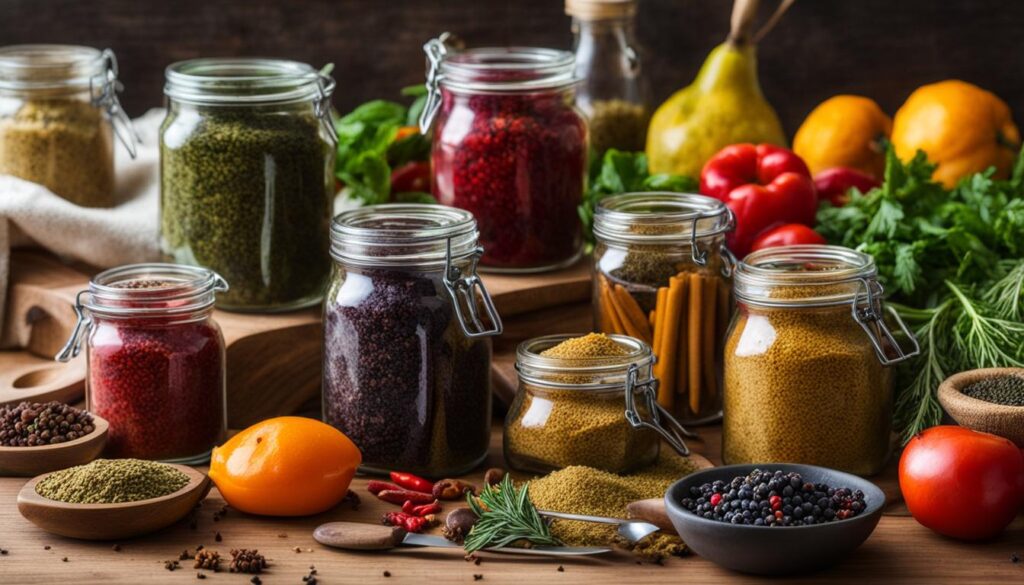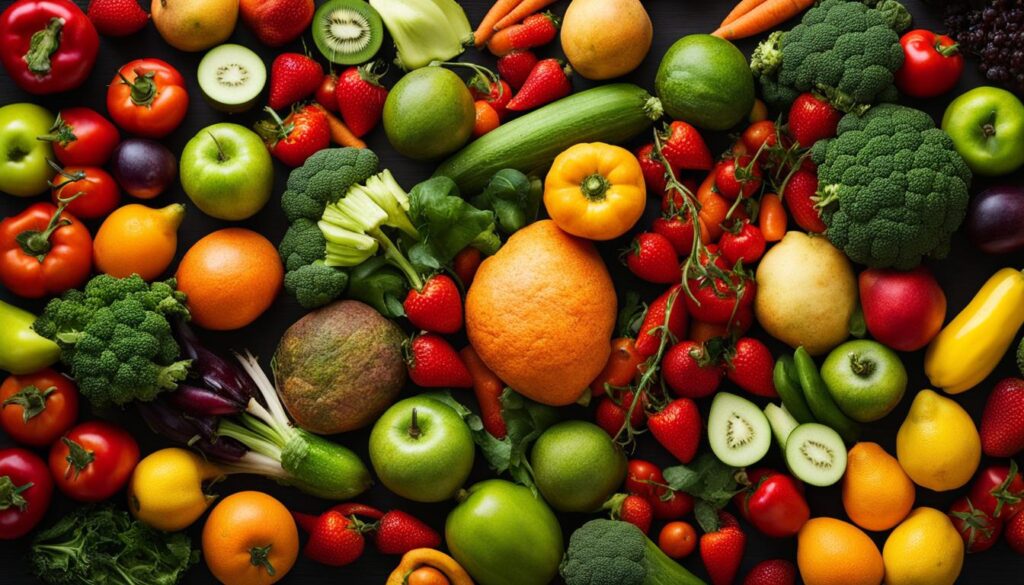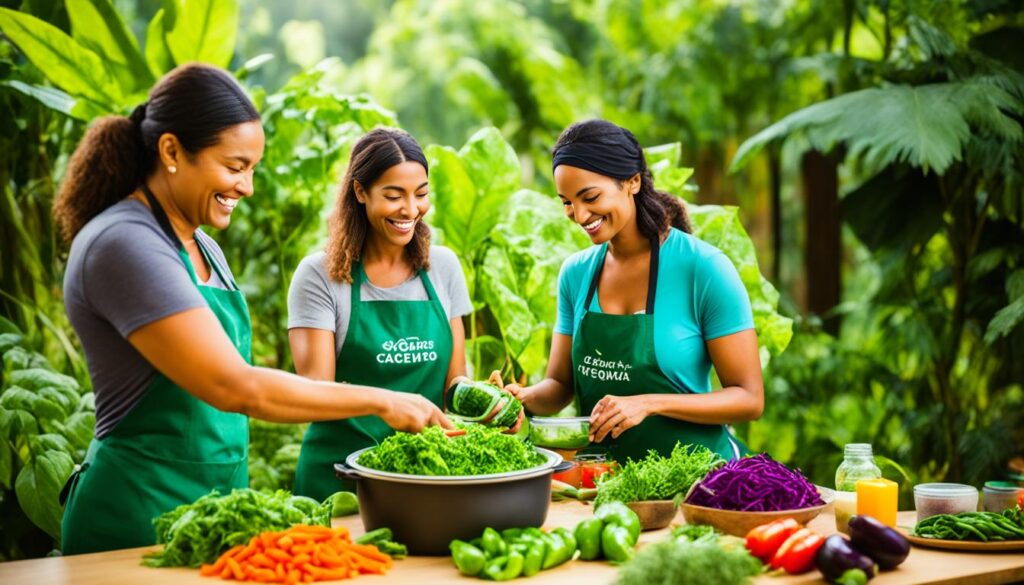Greetings! I’m excited to share with you the secrets of sustainable meal preppers and how they are transforming their diets to embrace a sustainable and eco-friendly approach. If you’re looking to incorporate sustainable eating habits into your meal planning, you’ve come to the right place.
Meal prepping has gained popularity for its time-saving and healthy benefits. But did you know that traditional meal prepping can sometimes lead to challenges such as food spoilage and limited variety? That’s where freeze-drying comes in as a game-changer.
By using freeze-dried ingredients, sustainable meal preppers extend the shelf life of their meals, reduce food waste, and enjoy a wide variety of options. Freeze-drying is a unique food preservation technique that retains the flavor, texture, and nutrients of food while removing its moisture content. This method offers several advantages, including extended shelf life, versatile ingredients, portion control, and nutrient retention.
Investing in a freeze dryer and incorporating freeze-dried ingredients into your meal prep routine can revolutionize your eating habits and contribute to a more sustainable lifestyle. Are you ready to embark on this exciting journey towards eco-friendly meal planning? Let’s dive in!
Key Takeaways:
- Meal prepping is a popular method for saving time and promoting healthier eating habits.
- Traditional meal prepping can lead to challenges like food spoilage and limited variety.
- Freeze-drying is a sustainable solution that extends shelf life, reduces food waste, and offers versatile ingredients.
- Investing in a freeze dryer and incorporating freeze-dried ingredients can revolutionize your meal prep routine.
- Sustainable meal prepping contributes to a more eco-friendly lifestyle and promotes a diverse range of meal options.
The Freeze-Drying Advantage for Sustainable Meal Prepping
Freeze-drying offers several advantages for sustainable meal prepping. This unique food preservation method allows freeze-dried foods to last for years without losing their nutritional value or taste. By stocking up on freeze-dried ingredients, you can reduce the need for frequent grocery trips and minimize food waste.
Freeze-dried ingredients are incredibly versatile and can be used in various recipes, adding variety to your meal prep routine. Additionally, freeze-drying allows you to portion your meals precisely, whether you’re preparing individual servings or meals for your entire family. Unlike other preservation methods, freeze-drying retains the nutritional content of the food, ensuring that you still receive the same health benefits as fresh ingredients.
I love incorporating freeze-dried ingredients into my meal prep routine. It’s like having a pantry full of fresh ingredients with an extended shelf life. I no longer worry about food going to waste, and I have more flexibility in planning my meals.
With freeze-dried foods, you can enjoy the convenience of having versatile ingredients readily available. Whether you’re making soups, stews, or smoothies, freeze-dried ingredients add flavor and texture to your dishes. They also provide portion control as you can easily measure the exact amount you need for your recipes.
Moreover, freeze-drying preserves the nutrients in the food, ensuring that you get the optimal health benefits. It’s a great way to maintain a nutritious diet and support your overall well-being.
Incorporating freeze-dried foods into your sustainable meal prep routine not only saves you time and money but also contributes to a greener planet. By reducing food waste and using versatile freeze-dried ingredients, you can take a small step towards a more sustainable and eco-friendly way of eating.
How to Incorporate Freeze-Drying into Your Meal Prep Routine
To incorporate freeze-drying into your meal prep routine, you’ll need a freeze dryer. There are various sizes available to suit your kitchen space. Once you have a freeze dryer, you can prepare your favorite fruits, vegetables, meats, and even full meals for freeze-drying. Experiment with different combinations to create exciting meal prep options.
When storing freeze-dried ingredients, airtight containers or mylar bags are essential. Make sure to label each container or bag with the date to ensure you use the oldest items first. This organization system will help you maintain a well-managed pantry and prevent food waste.
Incorporating freeze-dried ingredients into your meal prep repertoire is incredibly versatile. Whether you’re making smoothie packs, pasta dishes, or oatmeal, freeze-dried foods can add a delicious twist to your favorite recipes. They also provide a convenient and nutritious option for emergency preparedness, as they are lightweight, easy to store, and have a long shelf life. In times of crisis, having freeze-dried ingredients on hand can ensure essential nutrition for you and your family.
Examples of Freeze-Dried Meal Prep Options
| Meal | Ingredients |
|---|---|
| Smoothie Packs | Freeze-dried fruits (strawberries, bananas, blueberries) and vegetables (spinach, kale) |
| Pasta Dishes | Freeze-dried mushrooms, bell peppers, and onions |
| Oatmeal | Freeze-dried berries, nuts, and seeds |
| Emergency Meals | Freeze-dried meats (chicken, beef), vegetables, and grains (rice, quinoa) |

As you can see, freeze drying offers endless possibilities to elevate your meal prep routine. Whether you’re looking to enhance flavors, extend shelf life, or be prepared for emergencies, incorporating freeze-dried ingredients is a game-changer. So, get creative, stock up on your favorite freeze-dried ingredients, and revolutionize your meal prep experience!
The Environmental Benefits of a Plant-Based Diet
Adopting a plant-based diet has significant environmental benefits. Animal-based products are known to contribute to high amounts of global emissions, land degradation, and water pollution. By shifting towards a plant-based diet, you can help reduce greenhouse gas emissions and lower your carbon footprint.
Animal agriculture is a major contributor to worldwide nitrous oxide emissions and overall greenhouse emissions. It also uses a large percentage of agricultural land, leading to deforestation and habitat destruction. On the other hand, a plant-based diet reduces the demand for animal products, which in turn promotes the preservation of land, water, and biodiversity.
The Impact of a Plant-Based Diet on Greenhouse Gas Emissions
Animal agriculture accounts for a significant portion of greenhouse gas emissions, primarily methane and nitrous oxide. Methane is a potent greenhouse gas, and its production is linked to animal digestion and manure management. Nitrous oxide is released from the use of synthetic fertilizers in crop production, a practice often intensified in animal agriculture to feed livestock.
By reducing the consumption of animal products and adopting a plant-based diet, individuals can play a role in mitigating these emissions. Plant-based foods generally have lower carbon footprints compared to animal-derived products. The production of plant-based foods requires fewer resources and generates fewer emissions, contributing to a greener and more sustainable planet.
Preserving Land and Biodiversity through Plant-Based Diets
The demand for animal-based products drives the expansion of agricultural land, leading to deforestation and habitat destruction. Deforestation not only disrupts ecosystems but also contributes to climate change by reducing the earth’s capacity to absorb carbon dioxide.
By embracing a plant-based diet, you can reduce the demand for animal agriculture, which in turn helps preserve natural habitats and their rich biodiversity. Forests, grasslands, and wetlands support diverse plant and animal species, and by protecting these ecosystems, we can promote overall environmental health and safeguard our planet’s biodiversity.
“A shift towards plant-based diets can have a significant positive impact on reducing greenhouse gas emissions and preserving land and biodiversity.” – John Mackenzie, Environmental Scientist
Embracing a plant-based diet is a powerful way to make a positive impact on the environment while improving your own health and well-being. By reducing our reliance on animal-based products, we can help combat climate change, conserve land and biodiversity, and create a more sustainable future for generations to come.
Health Benefits of a Plant-Based Diet
In addition to the environmental benefits, adopting a plant-based diet offers numerous advantages for your overall health and well-being. By focusing on plant-based foods and reducing the consumption of animal products, you can experience a variety of health benefits:
- Lowering Inflammation: Plant-based diets have been shown to reduce inflammation in the body, which is a common underlying factor in many chronic diseases.
- Immune System Support: The abundance of fruits and vegetables in a plant-based diet provides essential nutrients, vitamins, and antioxidants that can support a healthy immune system.
- Reduced Risk of Cancer: Plant-based diets, rich in fruits, vegetables, and whole grains, have been associated with a reduced risk of certain types of cancer, such as colorectal and breast cancer.
- Overall Well-Being and Vitality: A plant-based diet can contribute to improved energy levels, mental clarity, and overall vitality, providing your body with the nutrients it needs for optimal functioning.
Furthermore, a plant-based diet has been linked to a lower risk of chronic diseases, including heart disease and type 2 diabetes. However, it is important to consult health and wellness experts, as well as educate yourself on the advantages of a plant-based diet, to ensure you are meeting your nutritional needs and managing any chronic illnesses effectively.

By embracing a plant-based diet, you not only contribute to a greener planet but also take a proactive approach to your own health and well-being.
Exploring Plant-Based Ingredients
As I transitioned to a plant-based diet, I discovered the importance of exploring a wide range of plant-based ingredients. These ingredients are the foundation of a nutritious and sustainable diet, offering valuable plant-based proteins, abundant fiber options, and plant-based fats and oils.
Plant-based proteins are essential for meeting our nutritional needs. They can be found in various sources such as legumes, nuts, seeds, and plant-based protein alternatives like tofu and tempeh. By incorporating these proteins into my meals, I ensure an adequate intake of nutrients and support my overall health and well-being.
A plant-based diet also provides abundant options for fiber. Fruits, vegetables, and whole grains are rich sources of fiber, supporting healthy digestion and regulating sugar levels. With a variety of fiber options available, I can create flavorful and satisfying meals that nourish my body from within.
Plant-based fats and oils play a crucial role in adding richness and flavor to my dishes. Avocados, olives, coconut oil, and nuts are excellent choices for cooking and flavoring meals. These sources of healthy fats provide essential fatty acids, contributing to a balanced and well-rounded diet.
Exploring plant-based ingredients has not only expanded my culinary repertoire but also helped me embrace a more sustainable way of eating. By incorporating plant-based proteins, abundant fiber options, and plant-based fats and oils into my meals, I have found a healthier and more environmentally friendly approach to nourishing my body.
Whether it’s experimenting with new recipes or creating plant-based twists on familiar favorites, there is a world of possibilities when it comes to exploring plant-based ingredients. Embracing these ingredients has been a transformative journey that has enriched my health, well-being, and connection with the planet.
Practical Tips for Embracing a Plant-Based Lifestyle
Transitioning to a plant-based lifestyle may seem daunting, but with some practical tips, you can make the process easier and more enjoyable. Here are some helpful suggestions to help you embrace a plant-based diet:
Gradual Transition
Start by incorporating more plant-based meals into your routine and gradually reduce the frequency of animal-based products. This gradual transition allows your taste buds and body to adapt to the changes easily. You can experiment with plant-based substitutes for your favorite meat and dairy products, such as tofu, tempeh, and nut-based cheeses.
Planning Balanced Meals and Snacks
It’s important to ensure you’re getting all the necessary nutrients from your plant-based meals. Plan balanced meals and snacks that incorporate a variety of vitamins, minerals, and healthy fats. Include a good mix of fruits, vegetables, whole grains, legumes, nuts, and seeds in your diet to meet your nutritional requirements. By doing so, you’ll feel satisfied and energized throughout the day.
Incorporating Seasonal and Local Produce
When planning your plant-based meals, consider incorporating seasonal and local produce whenever possible. Not only does this support local farmers and businesses, but it also reduces the carbon footprint associated with long-distance transportation. Seasonal and local produce is fresher, tastier, and packed with nutrients, making your meals even more enjoyable.
Meal Prepping for Convenience
Meal prepping can be a game-changer when embracing a plant-based lifestyle. It saves time, money, and reduces food waste. Dedicate some time each week to plan and prepare your meals in advance. This way, you’ll always have healthy and delicious plant-based options readily available. Consider batch cooking and freezing individual portions for busy days or when you need a quick meal.
Making Smart Substitutions
Get creative with your plant-based substitutions. Experiment with alternative ingredients and cooking methods to recreate your favorite recipes. For instance, instead of dairy milk, try using almond, soy, or oat milk. Swap eggs with ingredients like ground flaxseeds or applesauce in baking recipes. The possibilities are endless, and you may discover new flavors and textures you love.
“Transitioning to a plant-based lifestyle is not about restriction; it’s about exploring new foods and enjoying the incredible variety that nature offers.”
Staying Educated and Inspired
Stay informed and inspired by reading books, following blogs, and watching documentaries about plant-based living. Educate yourself on the health benefits, environmental impact, and ethical considerations of a plant-based diet. Surrounding yourself with like-minded individuals and joining online communities can provide support and motivation throughout your journey.
Remember, embracing a plant-based lifestyle is a personal choice, and it’s important to find a balance that works for you. Be patient with yourself and allow your taste buds and preferences to evolve over time. With planning, creativity, and a positive mindset, you’ll discover a whole new world of delicious and nourishing plant-based meals.

| Tips for Embracing a Plant-Based Lifestyle |
|---|
| Start with a gradual transition, incorporating more plant-based meals into your routine while reducing animal-based products. |
| Plan balanced meals and snacks that include a variety of fruits, vegetables, whole grains, legumes, nuts, and seeds. |
| Incorporate seasonal and local produce to support local farmers and enjoy fresh, nutrient-rich ingredients. |
| Save time and reduce food waste by meal prepping and batch cooking plant-based meals. |
| Experiment with plant-based substitutions to recreate your favorite recipes and discover new flavors. |
| Stay educated and inspired through books, blogs, documentaries, and online communities. |
Shopping with Sustainability in Mind
When it comes to shopping for eco-friendly meals, it’s essential to prioritize sustainable practices. This means paying attention to labels that indicate the use of environmentally-friendly and socially responsible production methods. Look for the following labels to ensure you’re making sustainable choices:
- Non-GMO Project – This label indicates that the product does not contain genetically modified organisms, supporting biodiversity and reducing the reliance on synthetic pesticides and fertilizers.
- Animal Welfare Approved – This label signifies that the animal products have been sourced from farms that prioritize animal welfare, providing fair conditions for the animals throughout their lives.
- USDA Organic – This label ensures that the products have been produced without the use of synthetic pesticides, hormones, or antibiotics, promoting healthier ecosystems and reducing chemical exposure.
- FairTrade – This label guarantees fair prices and wages for farmers and workers, supporting sustainable livelihoods and community development.
When choosing products, it’s important to avoid labels that are merely marketing phrases without any clear standards or audited certifications. Some labels may mislead consumers into thinking they are making sustainable choices when they aren’t.
Furthermore, shopping with sustainability in mind extends beyond just the labels. Supporting local economies by buying local food whenever possible not only reduces transportation distances but also helps to lower your carbon footprint. By purchasing from local farmers and businesses, you contribute to the local community, support regional biodiversity, and enjoy fresh, flavorful ingredients.
Incorporating Local Produce
Here is a table showcasing the benefits of incorporating local produce into your shopping:
| Benefits of Local Produce | Description |
|---|---|
| 1. Freshness | Local produce is harvested closer to its ripening stage, resulting in better taste and nutritional value. |
| 2. Reduced Carbon Footprint | Transporting locally grown food requires less fuel and produces fewer greenhouse gas emissions compared to long-distance transportation. |
| 3. Supporting Local Economies | Buying locally supports farmers and businesses in your community, fostering economic growth and job creation. |
| 4. Seasonality | Local produce is often seasonal, allowing you to enjoy a variety of flavors and support crop rotation practices. |
By understanding labels, choosing products with sustainability certifications, and supporting local economies through your shopping choices, you can contribute to a greener and more ethical food system.
The Importance of Meatless Monday and Conscious Seafood Choices
Implementing Meatless Monday, where you go meatless or vegan for one day per week, is an effective way to reduce emissions from animal agriculture. Animal agriculture is responsible for a significant percentage of greenhouse gas emissions. Additionally, making conscious choices about seafood can have a positive impact on the environment. Some fishing practices are unsustainable and contribute to ecological damage. Opt for local and sustainable seafood choices by checking labels and resources like Monterey Bay Aquarium’s SeafoodWatch.org, which provides information on safe and sustainable seafood options.
Reducing the consumption of animal products through initiatives like Meatless Monday can significantly decrease the environmental impact of animal agriculture. Animal agriculture contributes to greenhouse gas emissions, including carbon dioxide, methane, and nitrous oxide. By going meatless one day a week, you can help reduce these emissions and mitigate climate change.
“Meatless Monday is an easy way for individuals to make a positive impact on the environment. By consciously choosing to skip meat for just one day, we can reduce the demand for animal products and support more sustainable food systems.”
Seafood consumption also plays a role in sustainability. Overfishing, destructive fishing methods, and habitat destruction threaten marine ecosystems. By opting for local and sustainable seafood choices, you can support responsible fishing practices and ensure the long-term health of our oceans. Labels such as “Marine Stewardship Council (MSC)” and “Best Choice” from SeafoodWatch.org can help guide you towards environmentally friendly seafood options.
Benefits of Meatless Monday:
- Reduces greenhouse gas emissions from animal agriculture
- Conserves water resources
- Preserves land and biodiversity
- Promotes a more sustainable food system
Guidelines for Conscious Seafood Choices:
| Label/Resource | Description |
|---|---|
| Marine Stewardship Council (MSC) | Certification program that ensures sustainable fishing practices and seafood traceability |
| SeafoodWatch.org | Online resource providing information on safe and sustainable seafood choices |
| Best Choice | Recommended seafood options that are sustainable and have minimal environmental impact |
Incorporating Meatless Monday and making conscious seafood choices are small yet impactful steps towards a more sustainable and eco-friendly food system. By reducing our reliance on animal products and choosing sustainable seafood options, we can contribute to a healthier planet for future generations.
Minimizing Food Waste for a Greener Planet
Food waste is a significant issue that contributes to environmental problems. A study found that 40% of food in the US is wasted, with households wasting a quarter of the groceries they bring home. Minimizing food waste involves being mindful of the food you buy and ensuring it gets used. Plan meals ahead, use leftovers creatively, and practice proper storage techniques to extend the shelf life of food. By reducing food waste, you can contribute to a greener planet and save money in the process.
Here are some effective strategies for reducing food waste:
- Plan Meals Ahead: Take the time to plan your meals for the week. This will help you buy only what you need and avoid impulse purchases that may end up going to waste.
- Use Leftovers Creatively: Instead of throwing away leftovers, get creative and repurpose them into new meals. For example, leftover roasted vegetables can be turned into a delicious vegetable stir-fry the next day.
- Practice Proper Storage: Properly storing your food can help prolong its shelf life. Invest in airtight containers, use freezer bags for perishable items, and label them with the date to ensure you use the oldest items first.
- Compost Food Scraps: If you have food scraps that cannot be used or repurposed, consider starting a compost bin. Composting not only reduces food waste but also creates nutrient-rich soil for gardening.
“The only way forward, if we are going to improve the quality of the environment, is to get everybody involved.” – Richard Rogers
Reducing food waste is a collective effort that requires the participation of individuals, businesses, and governments. By implementing these strategies in our daily lives and advocating for food waste reduction on a larger scale, we can create a greener and more sustainable planet for future generations.
| Benefits of Reducing Food Waste | Solutions |
|---|---|
| 1. Environmental impact | 1. Plan meals ahead |
| 2. Economic savings | 2. Use leftovers creatively |
| 3. Conservation of resources | 3. Practice proper storage |
| 4. Reduction of greenhouse gas emissions | 4. Compost food scraps |
By implementing these solutions, we can collectively make a significant impact on reducing food waste and creating a greener planet.
Eating Out Responsibly
Eating out doesn’t have to compromise your eco-friendly eating habits. As a conscious diner, there are several ways you can enjoy a meal outside while still staying true to your sustainable lifestyle. One way is to look for certified green restaurants that prioritize sustainable practices in their operations.
Green restaurants are committed to reducing their environmental impact by implementing initiatives such as sourcing local and organic ingredients, minimizing food waste, conserving energy and water, and supporting fair trade practices. By dining at these establishments, you can support their efforts and contribute to a greener planet.
To find eco-friendly dining options, you can visit websites like GreenPages.org and DineGreen.com. These platforms provide resources and directories of green restaurants in your area. They often include information about the restaurant’s sustainability certifications, menu offerings, and customer reviews. This can help you make informed choices and find establishments that align with your values.
In addition to green restaurants, you can also explore apps like Happy Cow. This app specializes in helping users find vegan and vegetarian restaurants near their location. It provides valuable information about the restaurant’s menu, pricing, and customer ratings, ensuring you have a variety of options to choose from, regardless of your budget.
By supporting green and plant-based establishments, you not only enjoy a delicious meal, but also contribute to the growth of sustainable practices in the food industry. So the next time you dine out, be mindful of the choices you make and embrace the opportunity to eat out responsibly.

Conclusion
Embracing sustainable meal prepping and choosing an eco-friendly eating approach can have numerous benefits for your health and the planet. By incorporating freeze-dried ingredients into your meal prep routine, you can extend the shelf life of your meals, reduce food waste, and enjoy a wide variety of options. Freeze-drying retains the flavor, texture, and nutrients of food while contributing to a greener planet.
Adopting a plant-based diet is another crucial step towards a more sustainable lifestyle. By reducing the demand for animal products, you can help lower greenhouse gas emissions and preserve land and biodiversity. Plant-based diets offer numerous health benefits, including reducing inflammation, supporting the immune system, and decreasing the risk of chronic diseases.
When shopping for eco-friendly meals, pay attention to labels that indicate sustainable practices, such as the Non-GMO Project, Animal Welfare Approved, USDA Organic, and FairTrade. Supporting local economies by purchasing local food whenever possible also contributes to a greener planet.
By minimizing food waste through proper planning, creative use of leftovers, and storage techniques, you not only reduce environmental impact but also save money. Remember that small changes in your eating habits can make a significant impact. So, start your journey towards sustainable eating today and contribute to a healthier you and a greener planet!
FAQ
What are the advantages of freeze-drying for sustainable meal prepping?
Freeze-drying offers extended shelf life, versatile ingredients, portion control, and nutrient retention, reducing food waste and providing a wide range of options for sustainable meal prepping.
How can I incorporate freeze-drying into my meal prep routine?
To incorporate freeze-drying, you’ll need a freeze dryer. Once you have one, you can prepare your favorite ingredients and meals for freeze-drying, store them in airtight containers or mylar bags, and use them in various meal prep recipes.
What are the environmental benefits of a plant-based diet?
A plant-based diet helps reduce greenhouse gas emissions, preserves land and biodiversity, and reduces the negative impact of animal agriculture on the environment.
What health advantages does a plant-based diet offer?
A plant-based diet can reduce inflammation, support the immune system, lower the risk of cancer, promote overall well-being, and lower the risk of chronic diseases such as heart disease and type 2 diabetes.
What plant-based ingredients should I explore?
Explore plant-based proteins from sources like legumes, nuts, seeds, and alternatives like tofu and tempeh. Incorporate abundant plant-based fiber options from fruits, vegetables, and whole grains. Use plant-based fats and oils like avocados, olives, coconut oil, and nuts for cooking and flavoring.
What are some practical tips for embracing a plant-based lifestyle?
Start with a gradual transition, plan balanced meals and snacks, incorporate seasonal and local produce, and explore new plant-based ingredients to ensure a well-rounded and sustainable diet.
How can I shop with sustainability in mind?
Look for labels like Non-GMO Project, Animal Welfare Approved, USDA Organic, and FairTrade when shopping for eco-friendly meals. Support local economies by buying local food whenever possible and reduce your carbon footprint.
How can Meatless Monday and conscious seafood choices contribute to sustainability?
Implementing Meatless Monday and making conscious seafood choices can help reduce emissions from animal agriculture and support sustainable fishing practices, contributing to a greener planet.
How can I minimize food waste?
Minimize food waste by planning meals ahead, using leftovers creatively, and practicing proper storage techniques to extend the shelf life of food. By reducing food waste, you can contribute to a greener planet and save money.
How can I eat out responsibly?
Look for certified green restaurants that prioritize sustainable practices. Use resources like GreenPages.org and DineGreen.com to find eco-friendly dining options. Apps like Happy Cow can help you locate vegan and vegetarian restaurants near you, supporting your sustainable lifestyle.
How can sustainable meal prepping and eco-friendly eating benefit me?
By embracing sustainable meal prepping and eco-friendly eating, you can enjoy a healthy diet, reduce your carbon footprint, contribute to a greener planet, and support overall well-being and vitality.


[…] help you get started on your sustainable meal planning journey, here are 5 easy steps that even beginners can […]